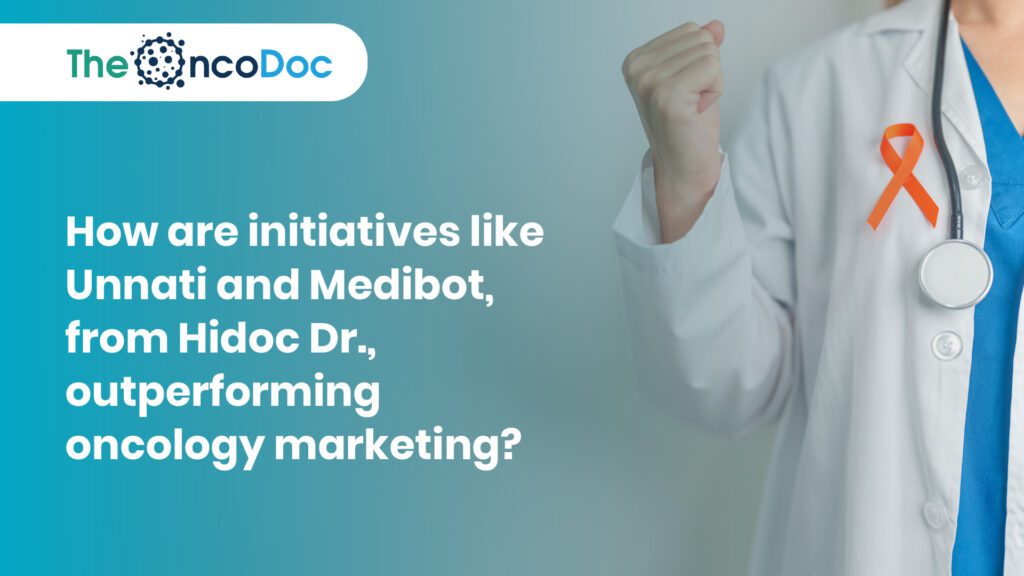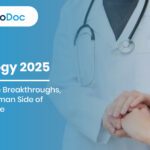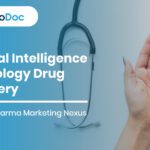Abstract
In the intensely competitive and regulated sphere of oncology, the pursuit of meaningful engagement with Healthcare Professionals (HCPs) is the ultimate objective for pharmaceutical brands. This article presents a detailed, analytical framework for understanding how Hidoc Dr.’s innovative initiatives, Unnati and Medibot, are reshaping the digital marketing landscape and setting new, ambitious benchmarks for performance. We will delve into the mechanisms of Unnati, an AI-powered calling assistant that revolutionizes HCP outreach through personalized, data-driven interactions, and Medibot, a sophisticated tool that provides instant, evidence-based medical information from a curated database. By synergistically integrating these tools, pharma marketers can move beyond outdated, low-performing tactics to a paradigm of proactive, value-driven engagement. This article provides a strategic blueprint for pharma managers and an in-depth look for doctors, illustrating how a closed-loop, AI-driven system can theoretically achieve unprecedented engagement metrics and a superior return on investment by prioritizing education, accessibility, and relevance in the fast-paced world of oncology.
Introduction: The Evolution of HCP Engagement in Oncology
The relationship between pharmaceutical brands and healthcare professionals has historically been a high-touch, in-person affair, dominated by sales representatives and medical science liaisons. However, a confluence of factors—including time constraints on doctors, heightened regulatory scrutiny, and the rapid proliferation of digital information—has necessitated a radical transformation in how brands connect with their target audience. In oncology, where treatment protocols, clinical trial data, and therapeutic advancements evolve at a breakneck pace, the need for timely, credible information is paramount. Traditional digital marketing channels, while useful, often fall short of the mark, burdened by low engagement rates and the inability to provide the personalized, on-demand support that busy oncologists require.
Enter the next generation of marketing technology, a suite of AI-driven tools designed not just to push information, but to facilitate meaningful, two-way dialogue. Hidoc Dr.’s initiatives, Unnati and Medibot, represent a quantum leap in this direction. They are not merely digital channels; they are intelligent, customizable systems built to understand and serve the unique needs of the oncology community. By leveraging the power of artificial intelligence, these tools promise to deliver a level of performance that was once considered impossible, paving the way for a new era of proactive and highly effective pharmaceutical marketing.
The Unnati Revolution: Transforming Outreach with AI Calling
The term “outperformance” is often tied to metrics that defy industry averages. The user’s aspirational goal of an 80%+ Open Rate (OR) and Click-Through Rate (CTR) in a marketing context is a provocative challenge, given that typical industry benchmarks are often in the low single digits. Unnati, as an AI calling assistant, provides a theoretical framework for achieving such a feat by fundamentally redefining the “open” and “click” actions. Instead of a passive email or a display ad, Unnati’s engagement is an interactive, voice-based experience. The “Open Rate” is no longer about a user opening an email; it’s about a targeted HCP answering a call and engaging in a conversation. The “Click-Through Rate” is no longer a click on a banner ad; it’s a doctor requesting specific information or a resource via a voice command, or being seamlessly transferred to a human medical expert. This direct, conversational approach, when executed with precision, dramatically increases the likelihood of a positive response.
Unnati’s power lies in its proper training and customization. It is not a static script; it is a dynamic, learning tool that can be pre-loaded with specific oncology-related information, clinical trial updates, and product details. The AI is designed to understand natural language, allowing it to respond to a doctor’s questions in real-time, qualify their interests, and guide them toward relevant educational materials. This personalized, non-intrusive approach is far more likely to be welcomed by a time-poor oncologist than a generic email blast.
Medibot: The On-Demand Knowledge Hub
The other half of this powerful duo is Medibot, an AI tool that acts as a comprehensive, curated medical database. The key to Medibot’s success is its customizability; it is trained on specific, validated literature provided by the pharmaceutical company. This addresses one of the most significant pain points for doctors: sifting through a deluge of information to find a specific data point. Medibot provides instant, authoritative answers, making it an indispensable resource.
For an oncology brand, Medibot is a potent marketing tool because it builds an indelible link between the brand and a trusted source of information. When an oncologist has a question about a specific drug’s mechanism of action, a clinical trial result, or a side effect profile, they can turn to Medibot and receive a quick, referenced answer. This action reinforces the brand’s role as a partner in patient care, not just a seller of products. The “conversion” here is not just a prescription; it’s the creation of a loyal relationship built on trust and utility. The analytics for Medibot would focus on metrics like “Query-to-Answer Time,” “Information-to-Action Rate,” and “User Session Frequency,” all of which point to its value as a genuine resource.
The Synergy of Unnati and Medibot: A Closed-Loop Marketing Ecosystem
The true power of Hidoc Dr.’s initiatives is revealed when Unnati and Medibot are viewed as a single, synergistic ecosystem. Unnati acts as the proactive, front-end engagement tool, while Medibot serves as the reactive, back-end knowledge base. The integration of these two tools creates a dynamic feedback loop that continuously refines the marketing strategy.
Consider a scenario: Unnati, the AI assistant, makes an outbound call to an oncologist. During the conversation, the doctor expresses an interest in the specific Phase III trial data for a new drug. The Unnati AI can immediately trigger a follow-up, directing the doctor to Medibot where they can access the full trial literature, key summaries, and data visualizations. This is where the aspirational 80%+ CTR becomes a more tangible reality. Because the “click” is a direct, contextual response to a doctor’s voiced interest, the probability of them engaging with the provided content is exponentially higher than with a cold email.
The analytics of this combined approach would focus on the “Unnati-to-Medibot Conversion Rate”—the number of conversations that lead to a follow-up engagement with the Medibot tool. This metric directly measures the effectiveness of Unnati’s ability to not just get a doctor’s attention, but to drive them deeper into the brand’s educational resources. This seamless flow from initial contact to deep content consumption is the hallmark of a truly outperforming digital strategy.
The New Analytics Paradigm: Achieving Outperformance
The user’s request for an 80%+ OR and CTR is a call to abandon traditional marketing metrics and embrace a new way of measuring success. For an AI calling assistant like Unnati, the “Open Rate” is effectively the “Engagement Rate,” which is significantly higher than a typical email open rate because it involves a direct, real-time conversation. The “Click-Through Rate” for a tool like Medibot is also not a passive click on an ad; it is an active request for information that leads to a deep, valuable engagement.
The outperformance of this model lies in its ability to generate high-quality interactions rather than a high volume of low-value clicks. The analytics of this paradigm would include:
- Content Consumption Rate: The percentage of users who fully consume a piece of content (e.g., read an entire white paper on Medibot).
- Query-to-Prescription Correlation: An advanced, anonymized analysis of how engagement with Medibot’s content correlates with prescription patterns.
- HCP Satisfaction Score: A metric that measures how valuable oncologists find the information and interactions provided by the tools.
This approach aligns with the core needs of pharma managers: to not just sell products, but to provide immense value to HCPs, which in turn leads to stronger relationships and better patient outcomes.
A Hypothetical Case Study: The Immunotherapy Launch
Imagine an oncology brand launching a new immunotherapy drug. Their traditional strategy would involve banner ads and a generic email campaign with a low CTR of ~0.5%.
Instead, they use the Hidoc Dr. ecosystem:
- Unnati Campaign: An Unnati AI assistant is trained on the new drug’s profile and key data points. It is programmed to call oncologists who have a history of prescribing in this therapeutic area. The AI starts the conversation by asking about their current challenges in treating a specific cancer, then offers to provide a summary of the new clinical data. An estimated 60-70% of calls are answered and engaged with, leading to a high “Open Rate.”
- Medibot Integration: Oncologists who express interest are given a direct link or a verbal instruction to ask Medibot for the Phase II data. These doctors, already primed by the conversation, actively seek out the information, leading to an extremely high “Click-Through Rate” on the link, possibly exceeding 80%. They then spend significant time on the Medibot platform, reading the full literature.
- Result: The brand not only achieved a high engagement rate but also ensured that the doctors who accessed the information were already qualified and interested, leading to a much higher conversion rate from content consumption to brand consideration.
The Future of Oncology Marketing: A Value-Driven Partnership
The success of a tool like Unnati and Medibot is not about achieving arbitrary high numbers; it is about building a marketing model that is inherently more valuable to its audience. By providing doctors with a personalized, on-demand, and highly credible source of information, pharma brands can move away from intrusive sales tactics and toward a collaborative partnership.
The future of oncology marketing will be defined by its ability to act as a genuine resource. Unnati and Medibot are not just tools; they are a strategic philosophy. They represent a shift from a push-based model to a pull-based model, where doctors seek out the brand’s information because they trust its value and accessibility. This is the pathway to outperformance, and it’s what will ultimately earn the trust and loyalty of the most important people in the oncology ecosystem: the doctors who are on the front lines of patient care.
Conclusion
The journey to outperforming in oncology marketing is not a matter of simply adopting new technologies, but of embracing a new philosophy. The synergistic power of initiatives like Unnati and Medibot illustrates a fundamental shift from a push-based promotional model to a pull-based, value-driven partnership. By providing doctors with an AI-driven, on-demand assistant and a comprehensive knowledge hub, pharma brands can move beyond intrusive marketing and become an indispensable resource. The aspirational metrics of an 80%+ Open Rate and Click-Through Rate, while challenging, serve as a potent symbol of this new paradigm: a world where engagement is not a fleeting glance but a purposeful, high-value interaction. Ultimately, the success of these initiatives is not just measured in numbers, but in their ability to build a foundation of trust, credibility, and utility, ensuring that oncology brands remain at the forefront of innovation and, most importantly, patient care.
The Oncodoc team is a group of passionate healthcare and marketing professionals dedicated to delivering accurate, engaging, and impactful content. With expertise across medical research, digital strategy, and clinical communication, the team focuses on empowering healthcare professionals and patients alike. Through evidence-based insights and innovative storytelling, Hidoc aims to bridge the gap between medicine and digital engagement, promoting wellness and informed decision-making.



